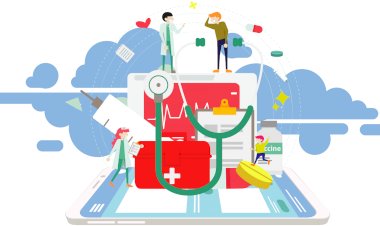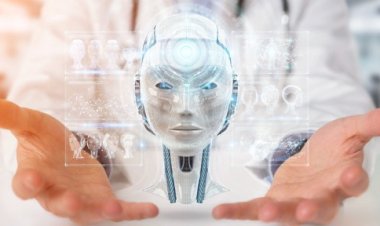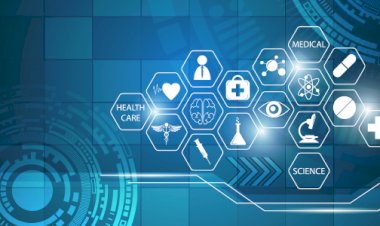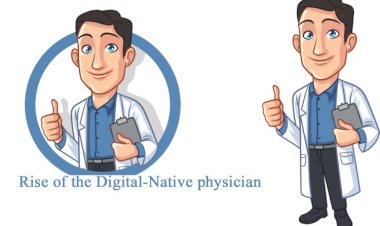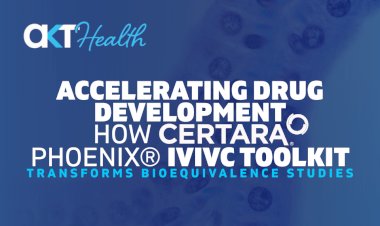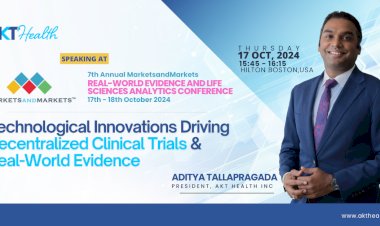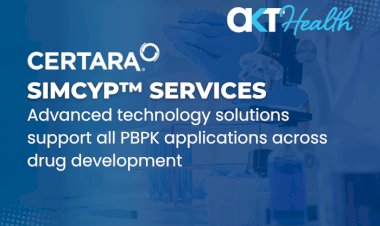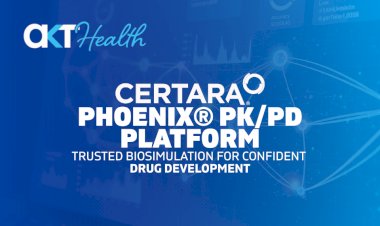How AI and Blockchain Impact Big Data Analytics in the Healthcare Industry
Massive amount of information through the digitization of everything known it as a Big Data. Collecting information from various sources and consolidating then that analysed from technologies to make a drastic change in healthcare.
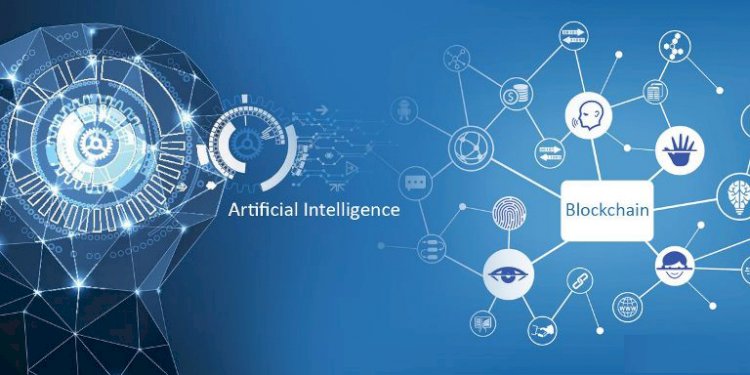
Massive amount of information through the digitization of everything known it as a Big Data. Collecting information from various sources and consolidating then that analysed from technologies to make a drastic change in healthcare. Healthcare analytics has the power to reduce costs, better patient outcomes, detecting and suggest methods to avoid preventable diseases and thereby improve quality of life. These made a better levels of treatment strategies, leading to an increase in the average human lifespan.
Large quality of clinical data and the method data is being analysed to perceive course, motifs and associations made this possible. Both statistical and quantitative analysis of the data helps healthcare systems come up with predictive and explanatory models. They are able to make fact-based decision and not just treatments based on assumptions.
Interestingly, there are 3 phases to data analysis, that’s applicable to all domains. They are Descriptive, Predictive and Prescriptive. In this article, we will examine all the three stages in detail, and how it’s combined with AI and Blockchain to provide better healthcare for patients.
Descriptive Analytics:
Descriptive analysis is about what has occurred. That is the thing that it is about — portrayal of the data that is gathered. For instance, what number of patients were conceded in clinic a year ago as casualties of engine vehicle mishaps? What number of fatalities happened in the mishaps, what number of them endured a contamination, etc?
Through distinct examination you can measure the data dependent on occasions and afterward convert them to comprehensible configuration. Thusly a progression of data in different configurations from different sources are changed over to noteworthy bits of knowledge that would be helpful in reaching determinations.
This is a rudimentary type of detailing, so it discusses occasions that have just happened. For instance, what number of are harrowed with diabetes consistently, what number of them are living with it, what are benchmark results and different parts of diabetic consideration. Despite the fact that it is fundamental, the announcing abilities of the data still escape the grip of numerous associations. This data must separated through different extraction strategies and that may add to the infrastructural expenses of the association. Nonetheless, except if there is a legitimate strategy to extricate this data, it would be everlastingly solidified in boundless structure — in a progression of numbers that don’t bode well. This is only the initial phase in utilizing data, and wellbeing focuses need to utilize this initial phase in big data examination
Predictive Analysis:
Predictive analysis is about expectations — what is probably going to occur. The data is there, presently what will occur? In what capacity will the data help to reach determinations? This is the situation looked by medicinal services segment — you have the data close by, presently what are you going to think about it. Inquisitively enough, truth be told, not very many social insurance suppliers have achieved the second stage — the phase of Predictive examination.
They need to utilize this data to diminish costs, achieve significant ends on the most proficient method to maintain a strategic distance from plagues, what steps ought to be taken to control constant illnesses, how to keep away from unfavourable occasions that may must be controlled, etc. Having a lot of data close by is only the start of the game, you should almost certainly make an important example out of it. For instance, in the event that you have a rundown of individuals who were readmitted with heart assaults, you can most likely investigation their medicine, way of life and different factors, and anticipate whether recently conceded heart assault patients will likewise have a repeat. Through prescient investigation, you can watch what would be inevitable and settle on choices that help you clinically.
EHR or Electronic Health Records that you find in the medical clinics is only the start. You need appropriate foundation to make legitimate bits of knowledge from this data, in light of the fact that simply having EHRs won’t do. For instance, having incorporated therapeutic gadgets that give the clinicians refreshed data about the patient’s imperative signs might be enormously useful in forestalling a repeat of a past occasion. Additionally, medical clinics can introduce clinical emotionally supportive networks that produce cautions and alerts that could be basic admonitions of a patient’s conditions.
In any case, these alarms must be real so they don’t influence the everyday practice of the clinicians and supportive in giving exact analysis on the patient’s condition. Numerous medicinal services suppliers are attempting their best to verify the foundation that add to prescient investigation, and have attempted their best to get the advancements that can battle the detours in accomplishing the guarantee conveyed by prescient examination.
Prescriptive Analysis:
This is the last phase of healthcare big data analysis. In the past stages, we found out about gathering the data, drawing bits of knowledge from it and making expectations dependent on the displayed data. Here in the last stage, the exchange isn’t simply on foreseeing an occasion, yet having the ability to take care of business. Assume, a territory all of a sudden has individuals getting conceded in medical clinics for an inquisitive instance of disease. Through prescient examination, the introduced programming system won’t simply hail this peculiarity from the data gathered from different emergency clinics, however will likewise stamp potential unfortunate casualties (individuals who are probably going to catch a similar contamination) and even give subtleties on the guardians so they can plan something for counteract spreading the illness themselves.
This demonstrates prescriptive investigation doesn’t simply anticipate shouldn’t something be said about’s to occur, it can help the medicinal services association on the various moves to be made to maintain a strategic distance from the conditions, and even recommend the most ideal strategy. For this, the human services associations ought to have best in class coordinated data examination framework to make this conceivable. In any case, the tragic part is that, lone a sprinkling of human services associations will almost certainly manage the cost of this in a huge scale way.
Be that as it may, the significance of prescriptive investigation is that it is the fate of medicinal services, and with the assistance of Internet of Things, the basic leadership capacities have taken a colossal jump forward. Web of Things makes it conceivable to take a gander at the calculations in an entirely unexpected manner and it is a noteworthy assistance too in light of the fact that the manner in which you can control these calculations have likewise experienced a monstrous change. Directly from a purchaser picking something from the basic food item shop to settling on pivotal securities exchange choices, the change has been progressive. So envision how it can impact the social insurance industry.
Prescriptive investigation can truly break the manner in which conventional method for finding and medications have been going on. They can achieve an entirely unexpected frame of mind to patient consideration.
Artificial Intelligence and Healthcare Big Data Analytics
A machine can be changed over into having Artificial Intelligence (AI) when it can see the encompassing condition and gather data that would help accomplish a specific objective. Through AI, data would be accumulated and after that connected to give canny arrangements. The utilizations of AI are far and wide, and particularly huge in medicinal services, account, financial matters and vitality utilization.
Man-made consciousness in healthcare makes it basically conceivable to settle on choices by watching the examples and giving better patient consideration. It can animate human conduct. AI is a center AI idea and comprises of PC frameworks that are displayed on the human cerebrum, After gathering calculations from the current data, there is staggered investigation that makes it workable for a gadget to invigorate and extend in the manner a mind does. This is done through profound discovering that perceives examples and gives recommendations through AI to frameworks to give prescient and prescriptive investigation.
Big data analysis can improve both organized and unstructured data, so it experiences patient records, wellbeing plans and different subtleties of the patient to give conclusion and medicines. For instance, envision a circumstance wherein a presumed malignant growth patient enters an emergency clinic for tests. The AI in the gadget gets a move on the patient totally, including every one of the cells. It can watch the example and quickly detect the oddity. Along these lines the specialists would rapidly have the option to recognize the carcinogenic cells and the non-harmful ones.
Blockchain and Healthcare Big Data Analytics
Blockchain is a kind of distributed ledger or decentralized ledger that contains unchangeable digitally recorded data packaged as blocks. As there are a number of decentralized database architecture, the data recorded in them is contingent on the simultaneous working of a number of resources rather than a single authority. These resources are participating members of a community, each with a ledger copy of its own.
The individuals share any useful info and choose which would be the latest one. When a legitimate exchange is recorded, it will be recorded on the blockchain, with a changeless timestamp. This timestamp can’t be adjusted or changed. When investigating other brought together advances, you can securely say that blockchain innovation is protected, straightforward and quick. This is a critical component on the grounds that in human services, precision and straightforwardness are significant highlights.
The most immediate applicability of blockchain is in the field of life sciences, primarily clinical preliminaries. This is on the grounds that it moves from the mistake inclined, record driven way to deal with an adaptable and increasingly solid procedure. The innovation has made its quality felt all over the place — including computerized reasoning (AI)- based diagnostics, interoperability, big data examination, data security, data sharing, Patient Engagement, Health Information Exchange (HIE), fighting counterfeit drugs, R&D diagnostics, etc.
There are three primary parts to a blockchain. They are: dispersed system, shared record and advanced exchanges. In disseminated arrange, the data structure will be spread over numerous nodes that could be in any area or district.
Shared record is a consistent segment and once the node application is running, you can check the content for that ecosystem in the separate ledger. The survey is according to the guidelines of that specific ecosystem. Cryptography assumes a significant job in blockchain. It is the thing that gives security to the multitudinous exchanges, legitimacy and permanence of data.
Being a distributed record of transactions, there are squares which are connected together in blockchain. Consequently you can say that this innovation is the fate of computerized exchanges. Insights regarding the patient and his/her wellbeing status can be imparted to different frameworks for further research or focused on advertising.
A model: Studying the conduct of another malady so as to achieve a choice on what sort of treatment would be great. Utilizing blockchain, the data will be shared among various research associations and they take a shot at finding a remedy for the uncommon malady. This present patient’s security and different subtleties will be ensured
Application of AI, Blockchain and Big Data Analytics in Healthcare
The impact of big data analytics in healthcare is staggering. The amount of data remains in both structured and unstructured formats unless some pattern is drawn from it. Big data analytics simplifies this data format, especially in-patient records, treatment plans, imaging data, insurance information, etc. Once a pattern is drawn from the data, it is shared among clinicians and medical research companies for various purposes, including research, diagnosis and treatment
It is Artificial Intelligence that helps in drawing the patterns in all the data that’s coming in. Apart from aiding in more efficient operations and insights into the patient, his lifestyle and health, AI can also help in leveraging the analytics for making strategic decisions. This is done by analyzing the algorithms and making highly complex decisions. So when a patient goes into a hospital with a life threatening disease, it is the computer that performs the diagnosis and suggests possible forms of treatments, even duration of hospital stay. The diagnosis will be accurate because the computer analyses loads of data, mostly making use of Google’s massive computing resources.
Hanover, the AI technology developed by Microsoft uses artificial super intelligence for mining data in the healthcare sector. Through this technology, it is possible for the devices to memorize medical research papers to find possible treatments for various patients. It will analyze the patient’s personal information by going through their medical history, corroborate it with the information from medical research papers and suggest effective treatments.
Blockchain technology plays a major role in determining and assuring the safety and transparency of drugs sold by pharmaceutical companies. It ensures that the data is recorded as it happens, and this is then shared analogously to provide better patient outcomes.
According to WHO estimates, about one million people die every year from counterfeit medicines. Through this technology, pharmaceutical companies like Big Pharma ensure that there will be no counterfeit drugs by providing each drug with a unique serial number. Once any drug with a fake number crosses the system, it will be instantly flagged. This can also ensure that drugs are not switched, point in shipment, poorly made, etc.
Tracking of the drugs is done through serialization unique identifiers in this manner — National Drug Code + Unique Serial Numbers. Under the DSCSA legislation, each pack of tablet, vial, syringe etc. has an individual unique serial number to identify the drug, where and when it was made. Blockchain helped in full traceability of drugs for Big Pharma.
The flowchart shows how structured and unstructured data flows through the various entities in the healthcare system, and how meaningful insights are created from all the collected data though Artificial Intelligence and Blockchain technology.
Blockchain helps in creating a system that creates and manages blocks of content known as ledgers, where the information analysis is secure and automated. All the health related data will be recorded and analysed securely so medical experts and healthcare providers and payers can get accurate updates. This is taken one step further by integrating AI algorithms into the blockchain. AI began to think and learn like the physician to understand the health trends and patterns. It collects the data from all the sources (the patient himself/herself, the radiologist through MRI scans and images in the form of unstructured data).
Conclusion
Data is the most crucial aspect in every industry, and in the healthcare sector, you cannot stress its importance in mere words. With proliferating volumes of data in the form of patient histories, EHRs and clinical trials, IT departments are looking forward to using the technologies of today to treat the diseases and health challenges that may strike tomorrow.
AI is an approach by which machines make use of data analytics to identify patterns that help in making crucial decisions, including relying on real time insights to prevent patient hospitalizations, determine the best course of treatment and streamline care delivery.
Similarly, Blockchain has evolved to be the norm in the healthcare sector. It’s value in the pharmaceutical supply chain, de-identified patient record transmission and medical billing is still being tried out. Together with AI, Blockchain can really make operations fast, safe, flexible and transparent. In the synergy of both these technologies, there is so much to explore, and yet, we have only reached the tip of the iceberg.
Looking to integrate AI, blockchain and big data analytics in your healthcare system? We can help you!

 Meghana
Meghana 






